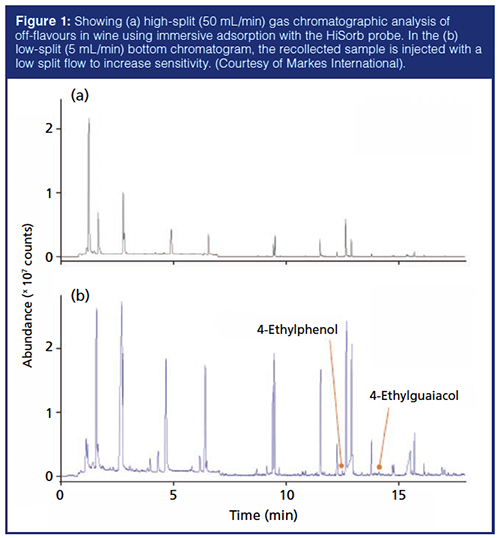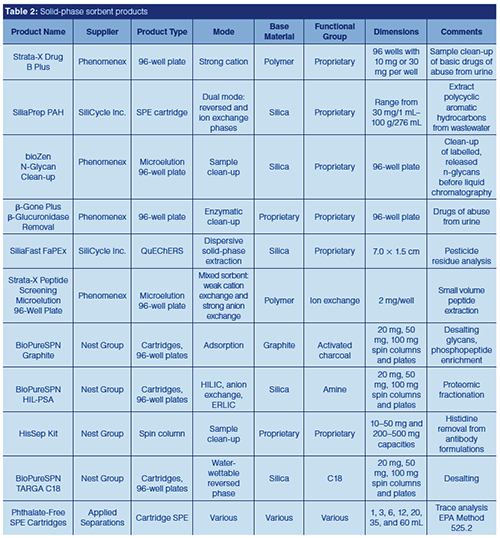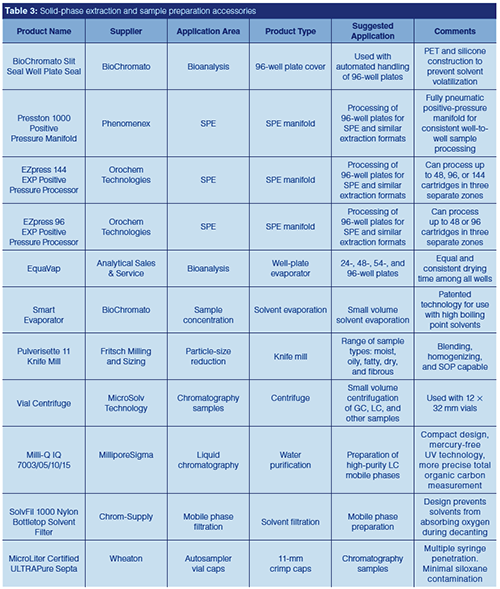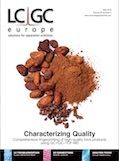New Sample Preparation Products and Accessories
LCGC Europe
This yearly report on new products introduced since March 2018 covers sample preparation instrumentation, supplies, and accessories.
This yearly report on new products introduced since March 2018 covers sample preparation instrumentation, supplies, and accessories.
In late 2018, the LCGC editorial staff submitted a survey to vendors of sample preparation products. Responses to this survey are compiled in this review, as are other new product introductions observed during the past 12 months. Note that I, for only the second time since 1990, did not attend Pittcon this year, so the additional information usually gained during the exposition is lacking from this year’s review.
New sample preparation technologies introduced in the past year were somewhat passive. Sorbents and accessories for solid-phase extraction (SPE) led the way, as did a multiplatform integration of sample preparation with gas chromatography (GC).
This review is presented in three sections. First, we discuss GC-specific sample preparation platforms and accessories. Next, new solid-phase sorbents and sorbent-based products are presented. Finally, we turn to other sample preparation accessories and supporting technologies. To assist the reader with some of the details behind these new products, each section presents a tabular summary of the associated products. In all cases, the new products we uncovered are presented in the annotated table, while the text highlights particularly noteworthy products.
Gas Chromatography–Specific Sample Preparation
A multiplatform sampling and concentration system for GC, Centri, was introduced by Markes International. A combination of robotics and analyte trapping is employed to accommodate a variety of sampling modes, including sorptive extraction, headspace sampling, solid-phase microextraction (SPME), and thermal desorption. The Centri’s HiSorb sorbent extraction uses a large volume of polydimethylsiloxane adsorbent on a robust metal tip, for robustness and enhanced sensitivity in either the headspace or immersive modes, for the extraction and characterization of volatile and semivolatile organic compounds. Another feature of the Centri is a recollection trap. High split flows can be used in the initial GC separation of volatile samples, to minimize sample overload. The recollected sample may be injected with lower split ratios for high sensitivity, as illustrated in Figure 1. Thermal desorption with the Centri can be in the passive sampling, pumped sampling, dynamic headspace sampling, or direct desorption modes. Additional details of the Centri product are found in Table 1.


Solid-Phase Sorbents and Products
Although solid-phase extraction (SPE) has matured, developments continue in a variety of modalities to improve the ease of method development, application range, and other pending criticisms of the various formats of the technique. This year, the developments seem much more limited than in previous years, and are primarily oriented towards bioanalysis. Phenomenex, SiliCycle, and Nest each introduced a family of new sorbents. The range of new sorbent-based product introductions is given in Table 2.

Phenomenex, primarily under the Strata-X family, developed the Strata-X Drug B Plus, bioZen N-Glycan CleanâUp, β-Gone Plus β-Glucuronidase Removal, and Strata-X peptide screening microelution 96-well plate products. The market for these products centres on analysis of drugs of abuse or enzyme hydrolysis. Each of the enzymeâhydrolysis products is in the microelution 96-well plate format, and allow in-well hydrolysis and filtrations. The extractions are cleaner than diluteâandâshoot samples, with low elution volumes, and shorter analysis times.
Meanwhile, the SiliCycle suite of products was developed for the environmental market. The SiliaFast FaPEx is an enhanced QuEChERSâtype cartridge for determination of a wide spectrum of pesticide residues in a faster method than more traditional approaches. The SiliaPrep PAH uses a proprietary endcapping with irregular silica of 40–63 μm, 60 Å, 500 m2/g 13% C, and a 2.0–10.0 pH range. This exact silica is available in bulk, SPE cartridge, and flash cartridge formats.

Products from the Nest Group are available in either µ-spin cartridge or 96-well plate formats. Desalting is a feature of these products, and the BioPureSPN HIL-PSA product used for proteomic fractionation provides a salt-free first dimension for twoâdimensional analysis, and can capture polyphosphorylated peptides. The HisSep Kit is designed for histidine removal from antibody formulations prior to polyacrylamide gel electrophoresis, and features 20–50 or 75–150 µL capacities. A water-wettable reversedâphase offering (BioPureSPN TARGA C18) is capable of loading 100% water to desalt glycans and phosphopeptides. Although novel sorbent phases or chemistries were not developed, Applied Separations launched a phthalate-free SPE cartridge available in a range of sizes that can be packed with any of their sorbents. For those using 96-well plates, BioChromato presented the BioChromato Slit Seal well plate seal, which features a threeâlayer polyethylene terephthalate and silicone construction for easy syringe penetration and prevention of solvent evaporation.
Constant, positive-pressure manifolds for SPE processing was the theme of products from Phenomenex and Orochem. Use of positive pressure, instead of vacuum manifolds, allows constant flow across each position in the manifold. The Presston 1000 manifold from Phenomenex has both high- and low-pressure gauges for use at a broad range of pressures. The Orochem EZpress is developed as two products to accommodate up to 96 or 144 one-millilitre cartridges, processed in two or three zones.
Sample Preparation Accessories and Related Products
Sample preparation accessories, including those previously discussed, are summarized in Table 3. Two new solvent evaporation systems were introduced in the past year. The EquaVap series from Analytical Sales & Services provides solvent evaporation from plates of 24, 48, 54, and 96 wells. The blowdown evaporators have an internal flow equalizer for equal output across all needle ports. The BioChromato Smart Evaporator accommodates single sample or up to 10 vials. A patented Spiral Plug technology allows evaporation of dimethylsulfoxide, dimethylformamide, and other high boiling solvents by placing solvents in a vacuum vortex under atmospheric pressure to eliminate bumping. This technology is diagrammed in Figure 2.

Other sample preparation accessories spanned a number of areas. Fritsch introduced the Pulverisette 11 knife mill for use with a range of sample types, from moist, oily, and fatty samples to dry and fibrous samples. The Vial centrifuge from MicroSolv Technology is utilized for small-volume samples associated with chromatography. The next generation Milli-Q system (IQ 7003/05/1015) from MilliporeSigma includes removal of colloids, particles, ions, and free chlorine, reverse osmosis, UV bacteria inactivation, and UV oxidation in a system with a smaller footprint than previous ultra-high purity water purifiers. When preparing mobile phases, a large membrane solvent filtration SolvFil 1000 Nylon Bottletop Solvent Filter is available from Chrom-Supply. A next generation of Wheaton vial caps (Microliter certified UltraPure septa) allows multiple syringe penetration, with minimal siloxane carryover to retard sample evaporation.
Conclusion and Future Directions
The trend, if any, emerging the past year seemed oriented towards bioanalysis, particularly using SPE technology. Whether the trend in coming years is aimed at toolâbuilding or problem-solving for food, environmental, and related analysis, is the question.
“Sample Prep Perspectives” editor Douglas E. Raynie is a department head and Associate Professor at South Dakota State University, USA. His research interests include green chemistry, alternative solvents, sample preparation, high-resolution chromatography, and bioprocessing in supercritical fluids. He earned his Ph.D. in 1990 at Brigham Young University under the direction of Milton L. Lee. Raynie is a member of LCGC’s editorial advisory board. Direct correspondence about this column to LCGCedit@mmhgroup.com

Silvia Radenkovic on Her Research and Passion for Scientific Collaboration
April 3rd 2025Radenkovic is a PhD candidate at KU Leuven and a member of FeMS. Her research focuses on inborn metabolic disorders (IMD), like congenital disorders of glycosylation (CDG), omics techniques such as tracer metabolomics, and different disease models.
Evaluating Natural Preservatives for Meat Products with Gas and Liquid Chromatography
April 1st 2025A study in Food Science & Nutrition evaluated the antioxidant and preservative effects of Epilobium angustifolium extract on beef burgers, finding that the extract influenced physicochemical properties, color stability, and lipid oxidation, with higher concentrations showing a prooxidant effect.










